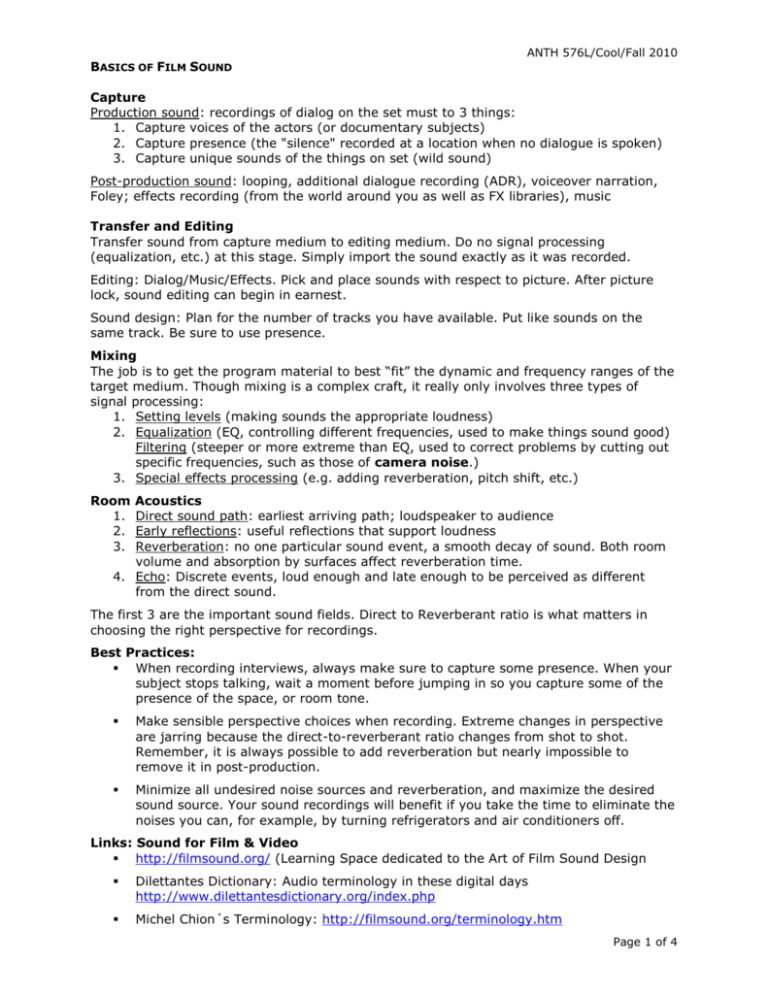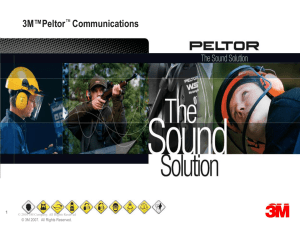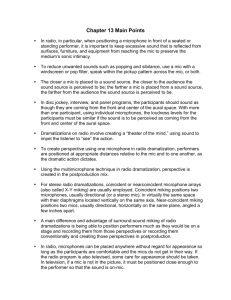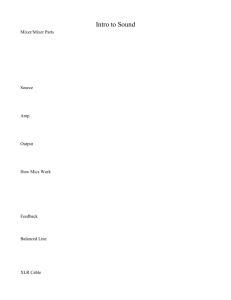Basics of Film Sound
advertisement

ANTH 576L/Cool/Fall 2010 BASICS OF FILM SOUND Capture Production sound: recordings of dialog on the set must to 3 things: 1. Capture voices of the actors (or documentary subjects) 2. Capture presence (the "silence" recorded at a location when no dialogue is spoken) 3. Capture unique sounds of the things on set (wild sound) Post-production sound: looping, additional dialogue recording (ADR), voiceover narration, Foley; effects recording (from the world around you as well as FX libraries), music Transfer and Editing Transfer sound from capture medium to editing medium. Do no signal processing (equalization, etc.) at this stage. Simply import the sound exactly as it was recorded. Editing: Dialog/Music/Effects. Pick and place sounds with respect to picture. After picture lock, sound editing can begin in earnest. Sound design: Plan for the number of tracks you have available. Put like sounds on the same track. Be sure to use presence. Mixing The job is to get the program material to best “fit” the dynamic and frequency ranges of the target medium. Though mixing is a complex craft, it really only involves three types of signal processing: 1. Setting levels (making sounds the appropriate loudness) 2. Equalization (EQ, controlling different frequencies, used to make things sound good) Filtering (steeper or more extreme than EQ, used to correct problems by cutting out specific frequencies, such as those of camera noise.) 3. Special effects processing (e.g. adding reverberation, pitch shift, etc.) Room 1. 2. 3. Acoustics Direct sound path: earliest arriving path; loudspeaker to audience Early reflections: useful reflections that support loudness Reverberation: no one particular sound event, a smooth decay of sound. Both room volume and absorption by surfaces affect reverberation time. 4. Echo: Discrete events, loud enough and late enough to be perceived as different from the direct sound. The first 3 are the important sound fields. Direct to Reverberant ratio is what matters in choosing the right perspective for recordings. Best Practices: When recording interviews, always make sure to capture some presence. When your subject stops talking, wait a moment before jumping in so you capture some of the presence of the space, or room tone. Make sensible perspective choices when recording. Extreme changes in perspective are jarring because the direct-to-reverberant ratio changes from shot to shot. Remember, it is always possible to add reverberation but nearly impossible to remove it in post-production. Minimize all undesired noise sources and reverberation, and maximize the desired sound source. Your sound recordings will benefit if you take the time to eliminate the noises you can, for example, by turning refrigerators and air conditioners off. Links: Sound for Film & Video http://filmsound.org/ (Learning Space dedicated to the Art of Film Sound Design Dilettantes Dictionary: Audio terminology in these digital days http://www.dilettantesdictionary.org/index.php Michel Chion´s Terminology: http://filmsound.org/terminology.htm Page 1 of 4 ANTH 576L/Cool/Fall 2010 Microphones Microphones can be categorized by: (a) method of transduction, and (b) polar pattern Transduction is like alchemy. It changes sound energy in the form of sound pressure into electrical energy. Methods of transduction: diaphragm (used in telephones); ceramic mic; dynamic mic; capacitor microphone; electric condenser mic. Dynamic condenser microphones are the most common in film sound capture on the set (or in the field). Compared to condenser condenser mics, dynamic condensers are much more rugged. Condensor mics always require a power supply to run. Microphone Polar Patterns Omnidirectional A microphone directivity pattern that responds to sound energy well from all directions. Likely to be dynamic or condenser mics. Because of diffraction, even omnidirectional mics have a front preference. This increases with mic size, so smaller ones are better. Bi-directional A microphone directivity pattern that responds to sound energy from two sides in a figure 8-shaped pattern. Usually a ribbon or condenser microphone. Cardioid A microphone directivity pattern that responds to sound energy in a generally heart-shaped pattern, with a null point located at the back of the mic. This pattern is useful because, by aiming the mic at the source, the relative pick up of the source compared to noise and reverberation in the room is enhanced over omni-directional mics. In addition to pointing the sensitive side of the mic at the desired source, the cardioid is also useful because one can point the null at the rear of the mic at an offending noise source (e.g., a film camera). Hypercardioid These microphones are similar to the cardioid but have a narrower front angle of acceptance, two symmetrical nulls rather than one straight in the rear, and a small “lobe,” showing sensitivity to sound from the rear of the mic. This small lobe can be useful in picking up questions and comments made by the camera operator. Shotgun (Interference tube) A microphone with a strong frontal sensitivity and with all other directions de-emphasized. It has the highest ration of direct to reverberant sound energy of all normally used mics, but suffers from changing directivity with frequency at any practical length. Also, most models show strong off-axis frequency response coloration. It is still probably the most often used production sound microphone in fiction filmmaking, i.e., on sets where a separate mic follows each actor. Page 2 of 4 ANTH 576L/Cool/Fall 2010 Some Key Terms & Concepts Speed of sound: 1,128 feet per second in air at sea level, room temperature, and 50% relative humidity. Varies with pressure, temperature, and humidity. Inverse Square Law: the property of sound waves to spread out as a function of distance away from a point source leads to a decreasing intensity of sound with distance. The “law” or rule that the fall off follows is a “square law,” that is, at twice the distance the amplitude of the sound is reduced by four times. Wavelength: for a sinusoidal pressure wave, the distance from peak to peak of the wave. The wavelengths corresponding to the audible frequency range vary from more than 50 feet to less than 1 foot. Frequency: for a sinusoidal pressure wave, frequency is the number of occurrences of one complete wave per second. The unit of frequency is Hertz (Hz) equal to one cycle per second. Related to wavelength and speed of sound through the equation: Frequency in Hertz = Speed of sound (feet/second) Wavelength (feet) The audible frequency range for human hearing is approximately 20 Hz to 20 kHz Amplitude: The size dimension of a waveform, usually represented vertically. Represents the strength of the unit being measured. Reflections: Sounds that do not take a direct route to a person’s ears, but which bounce first off of a stage, wall, or other non-absorptive boundary before arriving at the ears. The combined audio effect of all of the reflections of a sound is called reverberation. Diffraction: The bending of a sound wave around an obstacle and the reflection of a sound wave from an obstacle in its path is called diffraction. It is frequency dependent. Where the wavelength is short compared to the obstacle, reflection will occur as well as bending of the wave front. When the wavelength is long with respect to the obstacle, little reflection will occur and the bending will be more pronounced Absorption: Some materials absorb, rather than reflect, sound waves. More absorption provides more acoustical dampening. Tone: 1) Refers to a signal that has a particular and usually steady pitch. The simplest of tones are sine waves. (2) Tone also refers to timbre, or quality of a musical sound, such as "bright," "mellow," etc. (3) A synonym for whole-step, an interval of two half-steps, e.g., from C to D. (4) A synonym for note, i.e., any particular sound. Noise: (1) a sound that contains all the frequencies in the audible range. (2) An unwanted sound that is not related to the wanted sound (unwanted sounds that are related to the wanted sound are called distortion.) Noise is comprised of all audio frequencies at constantly varying amplitudes therefore it has no definable pitch or timbre. There are several different types of noise, such as: white noise, pink noise, residual noise, ambient noise, quantization noise, modulation noise. Pitch: The quality of a tonal sound as lower or higher; affected mostly by frequency of the sound, but also by sound pressure level and timbre. Timbre: The sensation related to a tonal sound that cannot be described by loudness, or by pitch. Related to harmonic structure, its balance across frequency and its changes in time. Precedence Effect (aka Law of the First Wavefront): The property of hearing to localize on the direction of the first arriving sound wave, despite later reflections. Cocktail Party Effect: At a gathering in a lively space where lots of people are chattering, a single mic will pick up only cacophony, whereas the human ear will be able to localize and discriminate among the sounds and hear specific speech. Related to speech mode. (Almost Page 3 of 4 ANTH 576L/Cool/Fall 2010 any simple noise, like white noise, can sound like speech if the person listening to it is in “speech mode”). Decibel (dB): A unit of measurement used to indicate audio power level, literally one-tenth of a bel, where the bel is a power ratio of 10:1. Technically, a decibel is a logarithmic ratio of two power measurements, which means that there is no such thing as a dB measurement in isolation. Imprecisely, 1dB is the smallest increment in loudness detectable by a careful listener. An increase of about 3dB is a doubling of electrical (or signal) power; an increase of 10dB is ten times more power, but is only a doubling of perceived loudness. Amplitude: The relative strength (amount) of a signal, without regard to its frequency content. Amplitude is the measurement of how much energy the sound has, i.e., the total change in air pressure during a single cycle of the sound wave. Amplitude is measured by determining the amount of fluctuation in air pressure (of a sound), voltage (of an electrical signal), or numerical data (in a digital application). When the signal is in the audible range, amplitude is perceived as loudness. Loudness: Subjective strength of a sound field. Equal Loudness Contours (aka Fletcher-Munson curves): Humans do not hear all frequencies as having equal loudness. In other words, human hearing is not liner in frequency. There is a marked drop-off in aural sensitivity to low frequencies. At the opposite extreme, humans have high sensitivity to sounds in the 1kHz-8kHz range, with sensitivity again dropping away above 12kHz. Equal Loudness Contours, as measured by Robinson and Dadson, 1956. In the graph above, the lines represent the sound pressure required for a test tone of any frequency to sound as loud as a test tone of 1 kHz. Take the line marked "60" at 1 kHz ("1" on the x-axis), the line marked "60" is at 60dB (on the y-axis). If you follow the "60" line down to 0.5 kHz (500 Hz), and look across to the y-axis, the value is about 55 dB. What this means is that a 500 Hz tone at 55 dB SPL sounds as loud to a human listener as a 1 kHz tone at 60 dB SPL. If human hearing were equally sensitive to all frequencies in the audible range, this graph would just be a series of horizontal lines. Page 4 of 4





